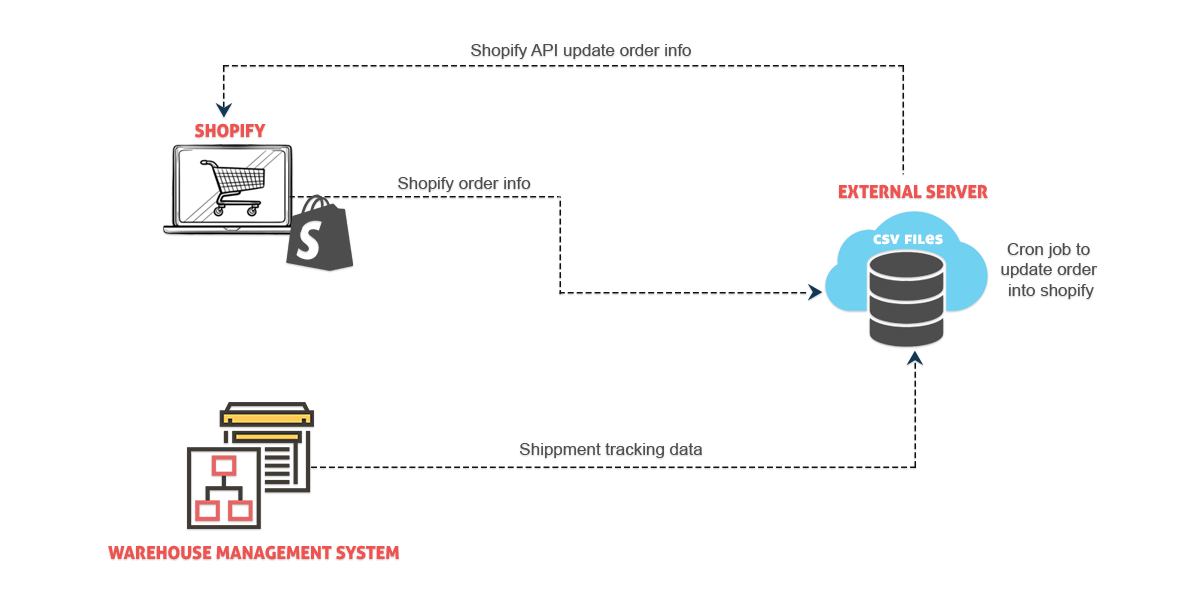Optimize eCommerce Supply Chain: WMS Integration For Shopify

Driven by the latest technology trends, the eCommerce sapling has grown into a full-blown tree – extending its branches in several directions and showing no signs of a halt.
E-commerce merchants around the globe are reaping tons of fruits in the form of leads and customers without being restricted to working hours, manual intervention or geographic borders as in the case with brick and mortar commerce model.
However, these enthralling web-based opportunities in the Commerce sphere have also generated some new challenges in the form of tons of data that needs to be effectively managed in order to establish an effective supply chain.
The longevity of these challenges directly resonates with the size of an organization. The larger the organization the more data it needs to deal with.
While smaller eCommerce businesses have options like Dropshipping to delegate the hassle of inventory management, mid and enterprise level organizations usually deal with the unimaginable amount of data on different fronts as they manage their own inventories (multiple warehouses in many instances).
Ironically, the eCommerce community has come up with several web-based solutions to manage these challenges on different business verticals. This includes utilizing different systems like:
- POS – Point of sale system for synchronizing brick and mortar stores with the online inventory
- CRM – Customer relationship management for providing support, handling human resources, monitoring marketing and conversion efforts.
- Accounting software – To manage accounts and generating invoices.
- ERP – Enterprise resource planning to manage all the back-end operations for large businesses.
- WMS – Warehouse management systems to manage one or many warehouses for an organization.
These tools help businesses to optimize eCommerce supply chain for their businesses and managing data and it’s synchronization across all channels of their business.
Being an expert eCommerce development company, we recently had the chance to integrate a WMS solution with Shopify for an enterprise level eCommerce business.
With this article, we will share our experience on how a WMS system can actually make a difference to optimize e-commerce supply chain and the best method to integrate a WMS system in common eCommerce CMS like – Magento, WooCommerce, Shopify, BigCommerce, etc.
WMS(Warehouse management system): In Theory
If you are managing your own inventory then a warehouse management software can substantially optimize eCommerce supply chain.
A WMS system is essentially a software that allows you to manage and track the movement of your inventory items from the moment it is received till the point it is shipped off to the customer.
This includes: logging the products within the inventory, managing returns, managing and tracking shipments and generating operational reports about different aspects of inventory.
Utilizing a digital tool to manage the entire process, WMS eliminates tons of paperwork, keep in check your inventory levels, reduce manual errors, and optimizes staff productivity.
How WMS can optimize eCommerce supply chain?
Your eCommerce CMS, whether you are using Magento, Shopify, BigCommerce or any similar tool that lets you create an eCommerce storefront, helps in setting up the interface for your users to review products and make orders.
Once the orders start coming in, the actual supply chain process kicks in. This process encapsulates different segments of your eCommerce business model.
These are:
-
Managing multi-channel selling
If you are generating orders from different sources other than an online website, such as a retail outlet, social media, Amazon, eBay, etc. it can get quite difficult to make sure that the inventory volume is synchronized throughout the omnichannel.
By utilizing a WMS that is managed at the warehouse level where products are actually assorted and managed, you can keep your inventory values synchronized at all times from a centralized location.
-
Managing multiple warehouses
Enterprise businesses often set up multiple warehouses on tactically finalized locations in order to provide fast deliveries and stay ahead of the competition.
For such business practice, a WMS becomes absolutely essential as the business can then manage inventory and analyze performance on both warehouse level and a combined level. As a business, you can easily set reorder points to replenish stock, identify dump and near expiry stocks, subsequently cutting down your losses.
-
Generate information for sales channels
One of the key importance of using a WMS is the analytics reports that it generates. While eCommerce already have a bunch of options to track orders and conversions through SAAS based analytics software, a WMS provides you reports for your entire omnichannel.
Such micro-level analytics for your product inventory can provide a lot of useful information for your sales team to plan discounts, price hikes, clearance sales, etc. This can be done on a sales channel basis, geographical location basis or product category basis.
-
Keeping accurate track of shipments and returns
The most important aspect of utilizing a WMS is to effectively manage shipping information for each product. A WMS makes sure that a shipment is not lost or returned due to human errors, and the complete track can be kept at different stages of the shipment.
Integrating WMS with eCommerce CMS
Once you are done setting up your WMS system for your Warehouse/s, it is essential to integrate it with your CMS system as well in order to exploit its full potential.
In an ideal scenario, your CMS system will record at least the following data about each order:
- Customer information
- Order information
- Shipping details
- Payment details
In order to make sure your WMS system remains in sync with the inventory data of your CMS both needs to be integrated at all times
The most ideal way to integrate any third party WMS in your eCommerce CMS – whether it is Magento, Shopify, BigCommerce or any other is by looking for a suitable extension/plugin.
These can be paid extensions available on the respective marketplace of the CMS or is provided by the WMS vendor itself. Hence it is advised to contact the support team of your WMS vendor once to confirm if they can provide an extension compatible with your CMS system.
However, there are so many CMS available in the market and you may encounter such an instance where there is no straightforward plugin available to integrate your WMS system with your CMS.
In such scenarios, the ideal way to proceed ahead is by requesting access to merchant API from your WMS system provider.
Although each API(Application programming interface) has its unique set of documentation with unique function, they are coded on the same format of JSON or XML in REST and SOAP.
These API functions can be used by creating a custom application that synchronizes data between your CMS and WMS
Our Experience: Integrating WMS with Shopify
Our Shopify development agency recently had the chance to develop a custom Shopify app that integrated Shopify with a third party WMS system.
Our client had set up a third party WMS software and was looking to synchronize the shipment details being recorded in their WMS with their Shopify website.
In order to achieve the same, we created a custom Shopify application that acted as an intermediate.
- The Shopify application used the Shopify’s client API to export order details in a CSV format and placed the file on the server
- The WMS system was integrated to fetch corresponding shipment tracking codes for each order and the same was updated in the CSV file
- As soon as the CSV file was updated, a CRON job was put in place to hit Shopify’s client API which updated the tracking code in Shopify’s order database
- This was done such that the end user was able to see the tracking details of the order and keep track of his shipment at all times
In a nutshell
This implementation was just the tip of the iceberg of what can be achieved in the landscape of WMS integration with CMS systems that you use to manage your websites. The possibilities are virtually endless.
Are you looking for an eCommerce development team that can integrate your WMS system with your CMS? Then get in touch with our experts today and engage in a free consultation session where we review your project scope, answer your queries, dissolve any ambiguities and help you discover new methods to optimize eCommerce supply chain.


